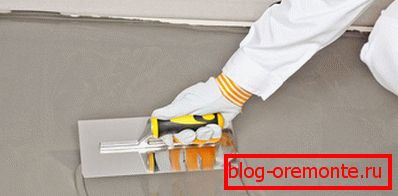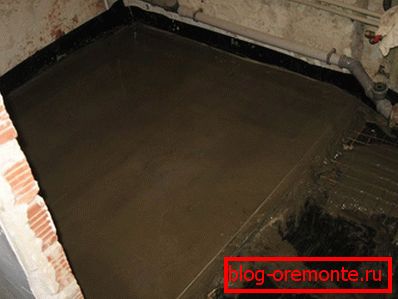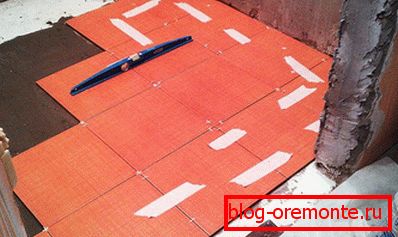How to put tiles on the bathroom floor
There is a material that has been used for thousands of years, but its manufacturing technology has undergone a small amount of changes. Various additives have been used, but nobody has canceled its roasting. This is a ceramic tile. It is unlikely that the ancient masters wondered how to put tiles on the floor in the bathroom. But we also live in the wrong time, so we will analyze this moment in detail.
Where do you start

Laying tiles начинается не с заливки стяжки, а с ее приобретения. Для ванной комнаты отличным решением будут такие виды, как керамогранит и клинкер, и вот почему:
- Bathroom implies an abundance of chemicals. They will certainly be poured on the floor. The resistance of the coating to the effects of liquids or powders of this kind is important.
- Water seeps into various pores and cracks. This may lead to delamination of the material. Moisture resistance is of paramount importance.
- If we enter in slippers, we can bring with us various debris that can damage the surface. Pay attention to abrasion resistance and bending stress.
Some more practical nuances:
- Select the size according to the room. On a small space, a tile of 1000 × 1000 mm will look awkward.
- It is better if the tile on the floor is not covered with glaze. This will be the key to your safety.
- Pay attention to the sides of the tile, they should be smooth without bevels and chips.
- If possible, choose a tile of the first grade. In all other cases, take with a margin on the percentage of marriage (in the second it is 25%, and in the third even more).
Coloring is a matter of your personal preference and taste. Remember that clinker is usually different natural tones without variegation and brightness.
Note! Pay attention to the labeling of the tile, for example, the applied AA symbols indicate its maximum resistance to chemicals. The literal value of PE and the next figure indicates the durability.
It is nice to put on even
The next step after buying the tile of the desired coloring and shade is to carry out the most difficult - leveling the floor, this is also true in a wooden house.

- On the old tile is better not to make laying - it must be dismantled. To do this, use a hammer drill with a chisel, or a hammer and a manual chisel. Whatever tool you use, you must take precautions.
- After the old tile is removed, we carefully clean the area. We sweep and collect all the garbage in the scoop.
- Determine how uneven the surface of the floor. We do this as follows: if there is a laser level, then use it. Turn on and beat off the plane at an arbitrary height. Take a tape measure and measure the distance from the line to the floor. We find a place where this distance will be the smallest - this is the highest point, and we will make a start from it. If there is no laser level, we proceed as follows: in an arbitrary place we put a mark on the wall. With the help of the water level we transfer this tag to all other walls. Next, measure the distance from this mark to the floor. The smallest - the highest point.
- Once you have identified the irregularities of the floor, they must be eliminated. To do this, decide what height the coupler will be.
- From the highest point found with the help of a tape measure put a label on which we raise the coupler.
- Using a laser level or water level, put two marks on each wall. We connect them with the help of chockline. Now we have a circled belt on which we can flood the floor.
 This kind of markup will work if we want to use a self-leveling compound. It will be a perfect and simple option. To do this, you will need to apply a damping tape on the wall, which compensates for expansion during freezing. Next, prepare the mixture, according to the instructions on the package. If the room is large, then divide it into zones with foam or other partitions. Fill the solution to the mark that we put. Carefully roll it out with a needle roller to expel the air. For these purposes also suitable comb spatula, which is applied to the glue tile. We expect complete drying. You can usually walk in 2? 4 hours, and lay tiles in 3? 7 days. When using a self-leveling mixture, in no case do not interfere with the hydration process - do not pour neither more nor less water. If you make the solution either too liquid, it will lose its strength, too thick - it will not be able to even out.
This kind of markup will work if we want to use a self-leveling compound. It will be a perfect and simple option. To do this, you will need to apply a damping tape on the wall, which compensates for expansion during freezing. Next, prepare the mixture, according to the instructions on the package. If the room is large, then divide it into zones with foam or other partitions. Fill the solution to the mark that we put. Carefully roll it out with a needle roller to expel the air. For these purposes also suitable comb spatula, which is applied to the glue tile. We expect complete drying. You can usually walk in 2? 4 hours, and lay tiles in 3? 7 days. When using a self-leveling mixture, in no case do not interfere with the hydration process - do not pour neither more nor less water. If you make the solution either too liquid, it will lose its strength, too thick - it will not be able to even out. If for any reason you do not want to use a self-leveling compound, then you can make a screed yourself. The flat line has already been repulsed, now you can put lighthouses on it. If you do not have special rails, then anything will do. Raise the lighthouses to the level of our label. We also check that all the beacons are in the same plane. Let them freeze so that we do not move them in the process of laying. Getting Started The mixture can be purchased already prepared or made independently. To do this, you need to mix 4 to 1 sand with cement grade 500, and also add a little tile glue (a shovel for a 15 liter bucket). Begin to start from the corner and move to the exit. We put the mixture on the surface and tighten it with the help of the rule. If there is no rule, then you can use a piece of profile or another flat bar. After leveling, let harden and harden.
If for any reason you do not want to use a self-leveling compound, then you can make a screed yourself. The flat line has already been repulsed, now you can put lighthouses on it. If you do not have special rails, then anything will do. Raise the lighthouses to the level of our label. We also check that all the beacons are in the same plane. Let them freeze so that we do not move them in the process of laying. Getting Started The mixture can be purchased already prepared or made independently. To do this, you need to mix 4 to 1 sand with cement grade 500, and also add a little tile glue (a shovel for a 15 liter bucket). Begin to start from the corner and move to the exit. We put the mixture on the surface and tighten it with the help of the rule. If there is no rule, then you can use a piece of profile or another flat bar. After leveling, let harden and harden.

Note! If you feel that the old surface is friable or even worse - there were boards under the old tiles, then you must dismantle everything. This is important, because if you leave everything as it is and pour fresh screed, then the wood will rot, a cavity will form, and everything will be ruined.
Laying tiles

Once we have created the perfect conditions, you can proceed to the main idea. For this we will need:
- spatula or trowel;
- spatula with a comb for applying glue;
- adhesive for tile;
- level;
- marker or pencil;
- Bulgarian;
- tile cutter;
- roulette;
- bucket for mortar;
- crosses for tiles;
- rubber mallet.
After collecting all the tools, you can proceed.
- Go to the bathroom and just look at it. It will be easier if the room is empty, although stacking can be done without cleaning the bath. Mark for yourself which areas immediately catch the eye and are constantly in sight.
- Prime the surface and allow to dry.
 By European standards, everything is done from the middle. A horizontal or vertical row is placed from the middle to one and the other wall, then perpendicular to it, and then the rest of the space is reported. But in our case, you can start from the door and the adjacent wall and move under the bath. So we can hide all the trimming in the far corners.
By European standards, everything is done from the middle. A horizontal or vertical row is placed from the middle to one and the other wall, then perpendicular to it, and then the rest of the space is reported. But in our case, you can start from the door and the adjacent wall and move under the bath. So we can hide all the trimming in the far corners.- Once you have decided on the place from which you start, you need to put a landmark. If the corridor is already laid tile and it comes close to the threshold of the bathroom, then it will be our beacon. We need to ensure their best fit. In another case, you will need to do the following: Draw a line on the threshold plane along which the tile should lie. Do this with a level to make it level. Now lay the tile resting on the plane of the wall and our line. So lay out a few rows, observing the suture gap. So you will see where trimming will be near the far wall. Put labels that will help you navigate.
- Prepare the glue according to the package instructions. It must be both non-liquid and not dry. The perfect consistency - thick sour cream.
 Apply glue to the floor surface. This can be done immediately on the area of two rows, which we tried on before. The layer should be uniform, and its height should not exceed the height of the tile. After that, walk on the glue with a comb. Take her from the place where the first tile to the far wall will lie. Need to hold at an angle of 45? 60 ?. Press down before you hear the characteristic shkryabanie on concrete. Lines must all be parallel, no need to wrap or place them perpendicularly. This is very important, because when you lay and press down the tiles, the voids will close and under the canvas there will be a solid lining without air gaps, which can cause pushing and damage to the tile.
Apply glue to the floor surface. This can be done immediately on the area of two rows, which we tried on before. The layer should be uniform, and its height should not exceed the height of the tile. After that, walk on the glue with a comb. Take her from the place where the first tile to the far wall will lie. Need to hold at an angle of 45? 60 ?. Press down before you hear the characteristic shkryabanie on concrete. Lines must all be parallel, no need to wrap or place them perpendicularly. This is very important, because when you lay and press down the tiles, the voids will close and under the canvas there will be a solid lining without air gaps, which can cause pushing and damage to the tile.- Now lay the tile on the resulting "rails". Press down a little and move it to lay the solution. If necessary, use a rubber mallet, tapping gently. Up to the wall, leave exactly the gap that can cover the baseboard or tile that will be on the wall. A little trick! If you look closely at the back side of the tile, then there may be arrows, if there are no arrows, then there may be some inscriptions or names. When you put the tile in two rows at once, lay it so that the arrow points to the arrow or the inscription to the inscription. So the rows will be smoother. This is due to the method of production. It happens that the machine gets off and one tile beats on the other. Even if this happened, the edges pointed to by the arrow will always be the same.
 After you have laid the first tile, check it with a level. Next put the second, put it on a level relative to the first. Set the crosses and check again by level. Practical advice! If you do not want to constantly run with the level, there is another interesting way with which you can check whether each element is evenly stacked. To do this, you need a laser level and a square. Install the laser level as low as possible and turn it on. Adjust it to beat the horizontal plane. Place a square on each corner of the tile. On a label of a level you will see, whether there is any of them above, and can correct it. So work will go much faster.
After you have laid the first tile, check it with a level. Next put the second, put it on a level relative to the first. Set the crosses and check again by level. Practical advice! If you do not want to constantly run with the level, there is another interesting way with which you can check whether each element is evenly stacked. To do this, you need a laser level and a square. Install the laser level as low as possible and turn it on. Adjust it to beat the horizontal plane. Place a square on each corner of the tile. On a label of a level you will see, whether there is any of them above, and can correct it. So work will go much faster.- You got to the place where the trim will lie. You can measure with a tape measure and transfer it to the tile. But make it easier. Turn the tile face down and press it against the wall, make the necessary gap and simply apply the label, focusing on the element that is already set on the glue. Cut the necessary part with a tile cutter. After that, put her in place.
Note! If you interfere with the toilet or stand for the sink, then at the time of laying them better to dismantle. So you do not have to perform complex trimming.
In this way, the entire area is covered. The second part of the room is better placed from the far wall so that you do not have to walk on fresh tiles. Walk around the seams and remove any glue residue.
We rub the seams
 For mashing the seams will need:
For mashing the seams will need:
- construction mixer;
- capacity;
- gasket;
- rubber spatula;
- ветошь из HB.
Prepare the mixture and let it stand for 10 minutes. All proportions are indicated on the packaging. Next, do the following:
- Apply grout to the joint with a rubber trowel. Perpendicular movement remove excess.
- After we have processed all the joints, we leave the entire surface for 20–30 minutes.
- After this time, you need to take a wet sponge and wash off the rest of the grout.
- Now you can also create a jointing, if you have the time and desire.
Note! Always choose the same color as the tile, or 1 × 2 lighter colors. Do not use too light shades. They will quickly get dirty and dirt will be noticeable.
Did you do it yourself right the first time? What difficulties arose in the course of work? Please share these points in the comments to the article. An experience shared with a friend is always doubled.
Video
You will learn more tips from the following footage: